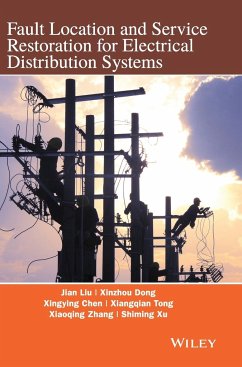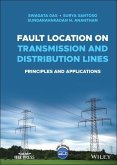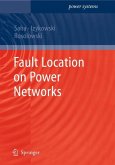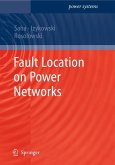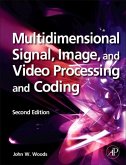Jian Guo Liu, Xinzhou Dong, Xingying Chen, Xiangqian Tong, Xiaoqing Zhang, Shiming Xu
Fault Location and Service Restoration for Electrical Distribution Systems
Jian Guo Liu, Xinzhou Dong, Xingying Chen, Xiangqian Tong, Xiaoqing Zhang, Shiming Xu
Fault Location and Service Restoration for Electrical Distribution Systems
- Gebundenes Buch
- Merkliste
- Auf die Merkliste
- Bewerten Bewerten
- Teilen
- Produkt teilen
- Produkterinnerung
- Produkterinnerung
In-depth and systemic examination of distribution automation with specific focus on fault location and service restoration * Focuses on the detailed and systemic examination of fault location and service restoration in distribution grid * Arms the readers with a complete picture of what fault location and service restoration is from both theoretical and practical perspectives * Presents the authors' research on fault location and restoration for distribution systems since 1995 * Introduces the first-hand application experience obtained from over 30 DAS (Distribution Automation System) projects…mehr
Andere Kunden interessierten sich auch für
![Fault Location on Transmission and Distribution Lines Fault Location on Transmission and Distribution Lines]() Swagata DasFault Location on Transmission and Distribution Lines147,99 €
Swagata DasFault Location on Transmission and Distribution Lines147,99 €![Positioning and Location-Based Analytics in 5g and Beyond Positioning and Location-Based Analytics in 5g and Beyond]() Positioning and Location-Based Analytics in 5g and Beyond137,99 €
Positioning and Location-Based Analytics in 5g and Beyond137,99 €![Fault Location on Power Networks Fault Location on Power Networks]() Murari Mohan SahaFault Location on Power Networks112,99 €
Murari Mohan SahaFault Location on Power Networks112,99 €![Upon the Electrical Experiments to Determine the Location of the Bullet in the Body of the Late President Garfield; and Upon a Successful Form of Induction Balance for the Painless Detection of Metallic Masses in the Human Body Upon the Electrical Experiments to Determine the Location of the Bullet in the Body of the Late President Garfield; and Upon a Successful Form of Induction Balance for the Painless Detection of Metallic Masses in the Human Body]() Alexander Graham BellUpon the Electrical Experiments to Determine the Location of the Bullet in the Body of the Late President Garfield; and Upon a Successful Form of Induction Balance for the Painless Detection of Metallic Masses in the Human Body33,99 €
Alexander Graham BellUpon the Electrical Experiments to Determine the Location of the Bullet in the Body of the Late President Garfield; and Upon a Successful Form of Induction Balance for the Painless Detection of Metallic Masses in the Human Body33,99 €![Fault Location on Power Networks Fault Location on Power Networks]() Murari Mohan SahaFault Location on Power Networks112,99 €
Murari Mohan SahaFault Location on Power Networks112,99 €![Multidimensional Signal, Image, and Video Processing and Coding Multidimensional Signal, Image, and Video Processing and Coding]() John W. WoodsMultidimensional Signal, Image, and Video Processing and Coding107,99 €
John W. WoodsMultidimensional Signal, Image, and Video Processing and Coding107,99 €![Location-Based Service Location-Based Service]() Location-Based Service22,99 €
Location-Based Service22,99 €-
-
-
In-depth and systemic examination of distribution automation with specific focus on fault location and service restoration * Focuses on the detailed and systemic examination of fault location and service restoration in distribution grid * Arms the readers with a complete picture of what fault location and service restoration is from both theoretical and practical perspectives * Presents the authors' research on fault location and restoration for distribution systems since 1995 * Introduces the first-hand application experience obtained from over 30 DAS (Distribution Automation System) projects in China * Examines the protection approaches of electrical distribution networks automation and on relevant mechanisms associated to electrical supply restoration after (local) blackouts
Hinweis: Dieser Artikel kann nur an eine deutsche Lieferadresse ausgeliefert werden.
Hinweis: Dieser Artikel kann nur an eine deutsche Lieferadresse ausgeliefert werden.
Produktdetails
- Produktdetails
- Verlag: Wiley
- Seitenzahl: 300
- Erscheinungstermin: 13. Dezember 2016
- Englisch
- Abmessung: 250mm x 175mm x 19mm
- Gewicht: 632g
- ISBN-13: 9781118950258
- ISBN-10: 1118950259
- Artikelnr.: 44559842
- Herstellerkennzeichnung
- Libri GmbH
- Europaallee 1
- 36244 Bad Hersfeld
- gpsr@libri.de
- Verlag: Wiley
- Seitenzahl: 300
- Erscheinungstermin: 13. Dezember 2016
- Englisch
- Abmessung: 250mm x 175mm x 19mm
- Gewicht: 632g
- ISBN-13: 9781118950258
- ISBN-10: 1118950259
- Artikelnr.: 44559842
- Herstellerkennzeichnung
- Libri GmbH
- Europaallee 1
- 36244 Bad Hersfeld
- gpsr@libri.de
Jian Liu, Professor, Xian University of Technology, China and Chief Engineer at Shaanxi Electric Power Research Institute, China Professor Liu received his Ph.D. in Electrical Engineering from Xi'an University of Technology, Xi'an, China. After graduation, he worked as an engineer at the Northwest Electric Power Corporation, as senior engineer at the Shaanxi Electric Power Corporation and Chief Engineer at the Shaanxi Electric Power Research Institute, respectively. Professor Liu started his research on distribution system and its automation in 1995. He established China's first urban Distribution Automation System (DAS) in Yinchuan Province. He published the paper 'The uniformed matrix algorithm of fault location for distribution systems' which was the country's first paper on fault location for distribution systems. He has published over 100 papers on modelling, analysis, planning, fault location, service restoration, network reconfiguration, feeder automation and self-healing for distribution systems. As the head of the DAS Testing Group of the State Grid Corporation of China, Prof. Liu established the DAS testing laboratory and has developed sets of simulation and testing equipment, and he has led and or supervised the testing work of over 80 DAS projects in China. He supervises all of the DAS standards of State Grid Corporation. Due to his contributions to electric power engineering, Prof. Liu has been awarded the national and provincial level of science and technology prizes on twelve occasions. He is a Senior Member of IEEE. Prof. Xinzhou Dong, Department of Electrical Engineering, Tsinghua University, China?CIEEE Fellow. Prof. Xingying Chen, Hohai University, China. Prof. Xiangqian Tong, Xi'an University of Technology, China. Mr. Xiaoqing Zhang, Senior Engineer, Shaanxi Electric Power Research Institute, China. Dr. Shming Xu, Senior Engineer, Shaanxi Electric Power Research Institute.
About the Authors ix
Preface xi
1 Progresses and Prospects for Fault Processing in Distribution Grids 1
Liu Jian
1.1 Introduction 1
1.2 Progresses in Local Intelligence?-Based Fault Processing 3
1.3 Progresses in Distributed Intelligence?-Based Fault Processing 3
1.4 Progresses in Centralized Intelligence?-Based Fault Processing 4
1.4.1 Fault Location 5
1.4.2 Fault Isolation and Service Restoration 5
1.5 Progresses in Single?]Phase Grounding Fault Processing 6
1.6 Prospects 7
2 Fault Processing Based on Local Intelligence 9
Tong Xiangqian and Liu Jian
2.1 Introduction 9
2.2 Fault Processing Based on Local Intelligence for Distribution Networks
10
2.2.1 Auto?-Reclosure Control 10
2.2.2 Automatic Backup Switching Control of the Reserve Source 11
2.2.3 Voltage Protection 13
2.2.4 Three-Section Over-Current Protection 14
2.2.5 Coordination between Current Protection Relaying and Auto-Reclosure
22
2.2.6 Directional Over?-Current Protection 23
2.2.7 Longitudinal Current Differential Protection 25
2.2.8 The Second Harmonic Braking Criterion in Current Protection 28
2.3 Fault Protection of the Active Distribution Network 32
2.3.1 The Influence of Distributed Generation on Current Protection and the
Adaptive Improvement of Protection 32
2.3.2 Influence of Distributed Generation on Auto?]Reclosure and its
Adaptive Improvements 38
2.3.3 Longitudinal Current Differential Protection of DG Connected
Distribution Networks 40
2.4 Coordination of Multistage Protection in the Distribution Network 41
2.4.1 Time Difference Based Coordination of Multistage Protection in the
Distribution Network 42
2.4.2 The Coordination of Multistage Protection Based on Three?]Section
Over?]Current Protection in the Distribution Network 50
2.4.3 Coordination Modes and Setting Methods of Multistage Protection of
Distribution Networks 58
2.4.4 Example Analysis 68
2.5 Summary 71
3 Fault Processing Based on Distributed Intelligence 73
Liu Jian, Xu Shiming and Chen Xingying
3.1 Introduction 73
3.2 FA based on Recloser and Voltage-Delay Type Sectionalizers 74
3.3 Reclosing with the Fast Over?-Current Protection Mode 78
3.3.1 Basic Principle 78
3.3.2 Improvements 80
3.4 Fast Healing Approach based on Neighbor Communication 82
3.4.1 Basic Principle 82
3.4.2 Improvements 85
3.5 Conclusion and Summary 88
4 Fault Processing Based on Centralized Intelligence 89
Liu Jian and Chen Xingying
4.1 Introduction 89
4.2 Simplified Modeling of Distribution Grids 92
4.2.1 Distribution Network Structure 92
4.2.2 Simplified Load Flow Analysis 98
4.3 Interphase Short Circuit Fault Location 103
4.3.1 Fault Location with Sufficient Information 103
4.3.2 Fault Location with Insufficient Information 111
4.3.3 Fault Location for Distribution Grids with DGs 117
4.4 Fault Isolation and Service Restoration 132
4.4.1 Fault Isolation 133
4.4.2 Service Restoration 135
4.4.3 Modeled Service Restoration 152
4.4.4 Coordination of the Four Types of Service Restoration 159
4.5 Conclusion and Summary 161
5 Single Phase to Ground Fault Processing 163
Dong Xinzhou and Shi Shenxing
5.1 Types of Ground Fault and Protection Strategy 164
5.1.1 The Neutral Grounding Mode and Ground Fault Types 164
5.1.2 The Protection Strategies for Different Types of Ground Faults 167
5.2 Detection of High Resistance Ground Faults in Low Resistance Grounded
Systems 168
5.2.1 High Resistance Ground Faults 168
5.2.2 Zero Sequence Inverse?-Time Overcurrent Protection 169
5.2.3 Grounded Protection based on the Amplitude and Phase of the Third
Harmonic Current 170
5.3 Grounding Protection in the System with Neutral Isolated 174
5.3.1 Characteristics of Single?-Phase-to-Ground Faults in Systems with
Neutral Isolated 174
5.3.2 Single?-Phase-to-Ground Protection in Grids with Neutral Isolated 179
5.4 Grounding Protection in the System with Neutral Grounded Through an Arc
Suppression Coil 180
5.4.1 Characteristics of Single-Phase-to-Ground Faults in Systems with
Neutral Grounded through an Arc Suppression Coil 181
5.4.2 Single?-Phase-to-Ground Protection in Systems with Neutral Grounded
through an Arc Suppression Coil 185
5.5 Single?-Phase-to?-Ground Fault Feeder Selection Technology in a Power
Distribution System with Neutral Non-Effectively Grounded 186
5.5.1 Comparison of Magnitude and Phase based Single?-Phase?-to-Ground
Fault Feeder Selection Methods 187
5.5.2 Characteristics of Single?-Phase-to-Ground Fault Generated Current
Traveling Waves 187
5.5.3 Current Traveling Wave?-based Fault Feeder Selection Method 194
5.6 Prevention of and Protection from Single?]Phase?]to?]Ground Faults in
Power Distribution Systems with Neutral Non?-Effectively Grounded 195
5.6.1 Basic Principle of Single-Phase-to-Ground Fault Prevention 195
5.6.2 Single?-Phase?-to-Ground Fault Prevention Technology 196
5.7 Single?-Phase?-to-Ground Fault Location in Systems with Neutral
Non?]Effectively Grounded 198
5.7.1 Single?-Phase-to-Ground Fault Generated Initial Traveling Waves 198
5.7.2 Single-Phase?-to?-Ground Fault Location Method based on Propagation
Speed of Traveling Waves 202
5.8 Conclusion and Summary 203
6 Practical Aspects of Fault Processing 204
Liu Jian and Zhang Xiaoqing
6.1 Introduction 204
6.2 Coordination of Fault Processing Approaches 205
6.2.1 Fault Processing Performance of Various Methodologies 205
6.3 Planning of Terminal Units 214
6.3.1 Elements Affecting the Reliability of Service 214
6.3.2 Cost?-Benefit Analysis of Action Node Planning 215
6.3.3 Planning the Amount of Terminal Units to Meet the Requirement of
Service Reliability 217
6.4 Verification of the Property of Fault Processing 226
6.4.1 Master Injection Testing Methodology and the Testing Tool 227
6.4.2 Secondary Synchronous Injection Testing Methodology and Testing
Facilities 231
6.4.3 Master and Secondary Synchronous Injection Testing Methodology 232
6.4.4 Direct Short-Circuit Test 234
6.4.5 Comparison of the Four Testing Methodologies 235
6.5 Conclusion and Summary 235
References 238
Index 242
Preface xi
1 Progresses and Prospects for Fault Processing in Distribution Grids 1
Liu Jian
1.1 Introduction 1
1.2 Progresses in Local Intelligence?-Based Fault Processing 3
1.3 Progresses in Distributed Intelligence?-Based Fault Processing 3
1.4 Progresses in Centralized Intelligence?-Based Fault Processing 4
1.4.1 Fault Location 5
1.4.2 Fault Isolation and Service Restoration 5
1.5 Progresses in Single?]Phase Grounding Fault Processing 6
1.6 Prospects 7
2 Fault Processing Based on Local Intelligence 9
Tong Xiangqian and Liu Jian
2.1 Introduction 9
2.2 Fault Processing Based on Local Intelligence for Distribution Networks
10
2.2.1 Auto?-Reclosure Control 10
2.2.2 Automatic Backup Switching Control of the Reserve Source 11
2.2.3 Voltage Protection 13
2.2.4 Three-Section Over-Current Protection 14
2.2.5 Coordination between Current Protection Relaying and Auto-Reclosure
22
2.2.6 Directional Over?-Current Protection 23
2.2.7 Longitudinal Current Differential Protection 25
2.2.8 The Second Harmonic Braking Criterion in Current Protection 28
2.3 Fault Protection of the Active Distribution Network 32
2.3.1 The Influence of Distributed Generation on Current Protection and the
Adaptive Improvement of Protection 32
2.3.2 Influence of Distributed Generation on Auto?]Reclosure and its
Adaptive Improvements 38
2.3.3 Longitudinal Current Differential Protection of DG Connected
Distribution Networks 40
2.4 Coordination of Multistage Protection in the Distribution Network 41
2.4.1 Time Difference Based Coordination of Multistage Protection in the
Distribution Network 42
2.4.2 The Coordination of Multistage Protection Based on Three?]Section
Over?]Current Protection in the Distribution Network 50
2.4.3 Coordination Modes and Setting Methods of Multistage Protection of
Distribution Networks 58
2.4.4 Example Analysis 68
2.5 Summary 71
3 Fault Processing Based on Distributed Intelligence 73
Liu Jian, Xu Shiming and Chen Xingying
3.1 Introduction 73
3.2 FA based on Recloser and Voltage-Delay Type Sectionalizers 74
3.3 Reclosing with the Fast Over?-Current Protection Mode 78
3.3.1 Basic Principle 78
3.3.2 Improvements 80
3.4 Fast Healing Approach based on Neighbor Communication 82
3.4.1 Basic Principle 82
3.4.2 Improvements 85
3.5 Conclusion and Summary 88
4 Fault Processing Based on Centralized Intelligence 89
Liu Jian and Chen Xingying
4.1 Introduction 89
4.2 Simplified Modeling of Distribution Grids 92
4.2.1 Distribution Network Structure 92
4.2.2 Simplified Load Flow Analysis 98
4.3 Interphase Short Circuit Fault Location 103
4.3.1 Fault Location with Sufficient Information 103
4.3.2 Fault Location with Insufficient Information 111
4.3.3 Fault Location for Distribution Grids with DGs 117
4.4 Fault Isolation and Service Restoration 132
4.4.1 Fault Isolation 133
4.4.2 Service Restoration 135
4.4.3 Modeled Service Restoration 152
4.4.4 Coordination of the Four Types of Service Restoration 159
4.5 Conclusion and Summary 161
5 Single Phase to Ground Fault Processing 163
Dong Xinzhou and Shi Shenxing
5.1 Types of Ground Fault and Protection Strategy 164
5.1.1 The Neutral Grounding Mode and Ground Fault Types 164
5.1.2 The Protection Strategies for Different Types of Ground Faults 167
5.2 Detection of High Resistance Ground Faults in Low Resistance Grounded
Systems 168
5.2.1 High Resistance Ground Faults 168
5.2.2 Zero Sequence Inverse?-Time Overcurrent Protection 169
5.2.3 Grounded Protection based on the Amplitude and Phase of the Third
Harmonic Current 170
5.3 Grounding Protection in the System with Neutral Isolated 174
5.3.1 Characteristics of Single?-Phase-to-Ground Faults in Systems with
Neutral Isolated 174
5.3.2 Single?-Phase-to-Ground Protection in Grids with Neutral Isolated 179
5.4 Grounding Protection in the System with Neutral Grounded Through an Arc
Suppression Coil 180
5.4.1 Characteristics of Single-Phase-to-Ground Faults in Systems with
Neutral Grounded through an Arc Suppression Coil 181
5.4.2 Single?-Phase-to-Ground Protection in Systems with Neutral Grounded
through an Arc Suppression Coil 185
5.5 Single?-Phase-to?-Ground Fault Feeder Selection Technology in a Power
Distribution System with Neutral Non-Effectively Grounded 186
5.5.1 Comparison of Magnitude and Phase based Single?-Phase?-to-Ground
Fault Feeder Selection Methods 187
5.5.2 Characteristics of Single?-Phase-to-Ground Fault Generated Current
Traveling Waves 187
5.5.3 Current Traveling Wave?-based Fault Feeder Selection Method 194
5.6 Prevention of and Protection from Single?]Phase?]to?]Ground Faults in
Power Distribution Systems with Neutral Non?-Effectively Grounded 195
5.6.1 Basic Principle of Single-Phase-to-Ground Fault Prevention 195
5.6.2 Single?-Phase?-to-Ground Fault Prevention Technology 196
5.7 Single?-Phase?-to-Ground Fault Location in Systems with Neutral
Non?]Effectively Grounded 198
5.7.1 Single?-Phase-to-Ground Fault Generated Initial Traveling Waves 198
5.7.2 Single-Phase?-to?-Ground Fault Location Method based on Propagation
Speed of Traveling Waves 202
5.8 Conclusion and Summary 203
6 Practical Aspects of Fault Processing 204
Liu Jian and Zhang Xiaoqing
6.1 Introduction 204
6.2 Coordination of Fault Processing Approaches 205
6.2.1 Fault Processing Performance of Various Methodologies 205
6.3 Planning of Terminal Units 214
6.3.1 Elements Affecting the Reliability of Service 214
6.3.2 Cost?-Benefit Analysis of Action Node Planning 215
6.3.3 Planning the Amount of Terminal Units to Meet the Requirement of
Service Reliability 217
6.4 Verification of the Property of Fault Processing 226
6.4.1 Master Injection Testing Methodology and the Testing Tool 227
6.4.2 Secondary Synchronous Injection Testing Methodology and Testing
Facilities 231
6.4.3 Master and Secondary Synchronous Injection Testing Methodology 232
6.4.4 Direct Short-Circuit Test 234
6.4.5 Comparison of the Four Testing Methodologies 235
6.5 Conclusion and Summary 235
References 238
Index 242
About the Authors ix
Preface xi
1 Progresses and Prospects for Fault Processing in Distribution Grids 1
Liu Jian
1.1 Introduction 1
1.2 Progresses in Local Intelligence?-Based Fault Processing 3
1.3 Progresses in Distributed Intelligence?-Based Fault Processing 3
1.4 Progresses in Centralized Intelligence?-Based Fault Processing 4
1.4.1 Fault Location 5
1.4.2 Fault Isolation and Service Restoration 5
1.5 Progresses in Single?]Phase Grounding Fault Processing 6
1.6 Prospects 7
2 Fault Processing Based on Local Intelligence 9
Tong Xiangqian and Liu Jian
2.1 Introduction 9
2.2 Fault Processing Based on Local Intelligence for Distribution Networks
10
2.2.1 Auto?-Reclosure Control 10
2.2.2 Automatic Backup Switching Control of the Reserve Source 11
2.2.3 Voltage Protection 13
2.2.4 Three-Section Over-Current Protection 14
2.2.5 Coordination between Current Protection Relaying and Auto-Reclosure
22
2.2.6 Directional Over?-Current Protection 23
2.2.7 Longitudinal Current Differential Protection 25
2.2.8 The Second Harmonic Braking Criterion in Current Protection 28
2.3 Fault Protection of the Active Distribution Network 32
2.3.1 The Influence of Distributed Generation on Current Protection and the
Adaptive Improvement of Protection 32
2.3.2 Influence of Distributed Generation on Auto?]Reclosure and its
Adaptive Improvements 38
2.3.3 Longitudinal Current Differential Protection of DG Connected
Distribution Networks 40
2.4 Coordination of Multistage Protection in the Distribution Network 41
2.4.1 Time Difference Based Coordination of Multistage Protection in the
Distribution Network 42
2.4.2 The Coordination of Multistage Protection Based on Three?]Section
Over?]Current Protection in the Distribution Network 50
2.4.3 Coordination Modes and Setting Methods of Multistage Protection of
Distribution Networks 58
2.4.4 Example Analysis 68
2.5 Summary 71
3 Fault Processing Based on Distributed Intelligence 73
Liu Jian, Xu Shiming and Chen Xingying
3.1 Introduction 73
3.2 FA based on Recloser and Voltage-Delay Type Sectionalizers 74
3.3 Reclosing with the Fast Over?-Current Protection Mode 78
3.3.1 Basic Principle 78
3.3.2 Improvements 80
3.4 Fast Healing Approach based on Neighbor Communication 82
3.4.1 Basic Principle 82
3.4.2 Improvements 85
3.5 Conclusion and Summary 88
4 Fault Processing Based on Centralized Intelligence 89
Liu Jian and Chen Xingying
4.1 Introduction 89
4.2 Simplified Modeling of Distribution Grids 92
4.2.1 Distribution Network Structure 92
4.2.2 Simplified Load Flow Analysis 98
4.3 Interphase Short Circuit Fault Location 103
4.3.1 Fault Location with Sufficient Information 103
4.3.2 Fault Location with Insufficient Information 111
4.3.3 Fault Location for Distribution Grids with DGs 117
4.4 Fault Isolation and Service Restoration 132
4.4.1 Fault Isolation 133
4.4.2 Service Restoration 135
4.4.3 Modeled Service Restoration 152
4.4.4 Coordination of the Four Types of Service Restoration 159
4.5 Conclusion and Summary 161
5 Single Phase to Ground Fault Processing 163
Dong Xinzhou and Shi Shenxing
5.1 Types of Ground Fault and Protection Strategy 164
5.1.1 The Neutral Grounding Mode and Ground Fault Types 164
5.1.2 The Protection Strategies for Different Types of Ground Faults 167
5.2 Detection of High Resistance Ground Faults in Low Resistance Grounded
Systems 168
5.2.1 High Resistance Ground Faults 168
5.2.2 Zero Sequence Inverse?-Time Overcurrent Protection 169
5.2.3 Grounded Protection based on the Amplitude and Phase of the Third
Harmonic Current 170
5.3 Grounding Protection in the System with Neutral Isolated 174
5.3.1 Characteristics of Single?-Phase-to-Ground Faults in Systems with
Neutral Isolated 174
5.3.2 Single?-Phase-to-Ground Protection in Grids with Neutral Isolated 179
5.4 Grounding Protection in the System with Neutral Grounded Through an Arc
Suppression Coil 180
5.4.1 Characteristics of Single-Phase-to-Ground Faults in Systems with
Neutral Grounded through an Arc Suppression Coil 181
5.4.2 Single?-Phase-to-Ground Protection in Systems with Neutral Grounded
through an Arc Suppression Coil 185
5.5 Single?-Phase-to?-Ground Fault Feeder Selection Technology in a Power
Distribution System with Neutral Non-Effectively Grounded 186
5.5.1 Comparison of Magnitude and Phase based Single?-Phase?-to-Ground
Fault Feeder Selection Methods 187
5.5.2 Characteristics of Single?-Phase-to-Ground Fault Generated Current
Traveling Waves 187
5.5.3 Current Traveling Wave?-based Fault Feeder Selection Method 194
5.6 Prevention of and Protection from Single?]Phase?]to?]Ground Faults in
Power Distribution Systems with Neutral Non?-Effectively Grounded 195
5.6.1 Basic Principle of Single-Phase-to-Ground Fault Prevention 195
5.6.2 Single?-Phase?-to-Ground Fault Prevention Technology 196
5.7 Single?-Phase?-to-Ground Fault Location in Systems with Neutral
Non?]Effectively Grounded 198
5.7.1 Single?-Phase-to-Ground Fault Generated Initial Traveling Waves 198
5.7.2 Single-Phase?-to?-Ground Fault Location Method based on Propagation
Speed of Traveling Waves 202
5.8 Conclusion and Summary 203
6 Practical Aspects of Fault Processing 204
Liu Jian and Zhang Xiaoqing
6.1 Introduction 204
6.2 Coordination of Fault Processing Approaches 205
6.2.1 Fault Processing Performance of Various Methodologies 205
6.3 Planning of Terminal Units 214
6.3.1 Elements Affecting the Reliability of Service 214
6.3.2 Cost?-Benefit Analysis of Action Node Planning 215
6.3.3 Planning the Amount of Terminal Units to Meet the Requirement of
Service Reliability 217
6.4 Verification of the Property of Fault Processing 226
6.4.1 Master Injection Testing Methodology and the Testing Tool 227
6.4.2 Secondary Synchronous Injection Testing Methodology and Testing
Facilities 231
6.4.3 Master and Secondary Synchronous Injection Testing Methodology 232
6.4.4 Direct Short-Circuit Test 234
6.4.5 Comparison of the Four Testing Methodologies 235
6.5 Conclusion and Summary 235
References 238
Index 242
Preface xi
1 Progresses and Prospects for Fault Processing in Distribution Grids 1
Liu Jian
1.1 Introduction 1
1.2 Progresses in Local Intelligence?-Based Fault Processing 3
1.3 Progresses in Distributed Intelligence?-Based Fault Processing 3
1.4 Progresses in Centralized Intelligence?-Based Fault Processing 4
1.4.1 Fault Location 5
1.4.2 Fault Isolation and Service Restoration 5
1.5 Progresses in Single?]Phase Grounding Fault Processing 6
1.6 Prospects 7
2 Fault Processing Based on Local Intelligence 9
Tong Xiangqian and Liu Jian
2.1 Introduction 9
2.2 Fault Processing Based on Local Intelligence for Distribution Networks
10
2.2.1 Auto?-Reclosure Control 10
2.2.2 Automatic Backup Switching Control of the Reserve Source 11
2.2.3 Voltage Protection 13
2.2.4 Three-Section Over-Current Protection 14
2.2.5 Coordination between Current Protection Relaying and Auto-Reclosure
22
2.2.6 Directional Over?-Current Protection 23
2.2.7 Longitudinal Current Differential Protection 25
2.2.8 The Second Harmonic Braking Criterion in Current Protection 28
2.3 Fault Protection of the Active Distribution Network 32
2.3.1 The Influence of Distributed Generation on Current Protection and the
Adaptive Improvement of Protection 32
2.3.2 Influence of Distributed Generation on Auto?]Reclosure and its
Adaptive Improvements 38
2.3.3 Longitudinal Current Differential Protection of DG Connected
Distribution Networks 40
2.4 Coordination of Multistage Protection in the Distribution Network 41
2.4.1 Time Difference Based Coordination of Multistage Protection in the
Distribution Network 42
2.4.2 The Coordination of Multistage Protection Based on Three?]Section
Over?]Current Protection in the Distribution Network 50
2.4.3 Coordination Modes and Setting Methods of Multistage Protection of
Distribution Networks 58
2.4.4 Example Analysis 68
2.5 Summary 71
3 Fault Processing Based on Distributed Intelligence 73
Liu Jian, Xu Shiming and Chen Xingying
3.1 Introduction 73
3.2 FA based on Recloser and Voltage-Delay Type Sectionalizers 74
3.3 Reclosing with the Fast Over?-Current Protection Mode 78
3.3.1 Basic Principle 78
3.3.2 Improvements 80
3.4 Fast Healing Approach based on Neighbor Communication 82
3.4.1 Basic Principle 82
3.4.2 Improvements 85
3.5 Conclusion and Summary 88
4 Fault Processing Based on Centralized Intelligence 89
Liu Jian and Chen Xingying
4.1 Introduction 89
4.2 Simplified Modeling of Distribution Grids 92
4.2.1 Distribution Network Structure 92
4.2.2 Simplified Load Flow Analysis 98
4.3 Interphase Short Circuit Fault Location 103
4.3.1 Fault Location with Sufficient Information 103
4.3.2 Fault Location with Insufficient Information 111
4.3.3 Fault Location for Distribution Grids with DGs 117
4.4 Fault Isolation and Service Restoration 132
4.4.1 Fault Isolation 133
4.4.2 Service Restoration 135
4.4.3 Modeled Service Restoration 152
4.4.4 Coordination of the Four Types of Service Restoration 159
4.5 Conclusion and Summary 161
5 Single Phase to Ground Fault Processing 163
Dong Xinzhou and Shi Shenxing
5.1 Types of Ground Fault and Protection Strategy 164
5.1.1 The Neutral Grounding Mode and Ground Fault Types 164
5.1.2 The Protection Strategies for Different Types of Ground Faults 167
5.2 Detection of High Resistance Ground Faults in Low Resistance Grounded
Systems 168
5.2.1 High Resistance Ground Faults 168
5.2.2 Zero Sequence Inverse?-Time Overcurrent Protection 169
5.2.3 Grounded Protection based on the Amplitude and Phase of the Third
Harmonic Current 170
5.3 Grounding Protection in the System with Neutral Isolated 174
5.3.1 Characteristics of Single?-Phase-to-Ground Faults in Systems with
Neutral Isolated 174
5.3.2 Single?-Phase-to-Ground Protection in Grids with Neutral Isolated 179
5.4 Grounding Protection in the System with Neutral Grounded Through an Arc
Suppression Coil 180
5.4.1 Characteristics of Single-Phase-to-Ground Faults in Systems with
Neutral Grounded through an Arc Suppression Coil 181
5.4.2 Single?-Phase-to-Ground Protection in Systems with Neutral Grounded
through an Arc Suppression Coil 185
5.5 Single?-Phase-to?-Ground Fault Feeder Selection Technology in a Power
Distribution System with Neutral Non-Effectively Grounded 186
5.5.1 Comparison of Magnitude and Phase based Single?-Phase?-to-Ground
Fault Feeder Selection Methods 187
5.5.2 Characteristics of Single?-Phase-to-Ground Fault Generated Current
Traveling Waves 187
5.5.3 Current Traveling Wave?-based Fault Feeder Selection Method 194
5.6 Prevention of and Protection from Single?]Phase?]to?]Ground Faults in
Power Distribution Systems with Neutral Non?-Effectively Grounded 195
5.6.1 Basic Principle of Single-Phase-to-Ground Fault Prevention 195
5.6.2 Single?-Phase?-to-Ground Fault Prevention Technology 196
5.7 Single?-Phase?-to-Ground Fault Location in Systems with Neutral
Non?]Effectively Grounded 198
5.7.1 Single?-Phase-to-Ground Fault Generated Initial Traveling Waves 198
5.7.2 Single-Phase?-to?-Ground Fault Location Method based on Propagation
Speed of Traveling Waves 202
5.8 Conclusion and Summary 203
6 Practical Aspects of Fault Processing 204
Liu Jian and Zhang Xiaoqing
6.1 Introduction 204
6.2 Coordination of Fault Processing Approaches 205
6.2.1 Fault Processing Performance of Various Methodologies 205
6.3 Planning of Terminal Units 214
6.3.1 Elements Affecting the Reliability of Service 214
6.3.2 Cost?-Benefit Analysis of Action Node Planning 215
6.3.3 Planning the Amount of Terminal Units to Meet the Requirement of
Service Reliability 217
6.4 Verification of the Property of Fault Processing 226
6.4.1 Master Injection Testing Methodology and the Testing Tool 227
6.4.2 Secondary Synchronous Injection Testing Methodology and Testing
Facilities 231
6.4.3 Master and Secondary Synchronous Injection Testing Methodology 232
6.4.4 Direct Short-Circuit Test 234
6.4.5 Comparison of the Four Testing Methodologies 235
6.5 Conclusion and Summary 235
References 238
Index 242

